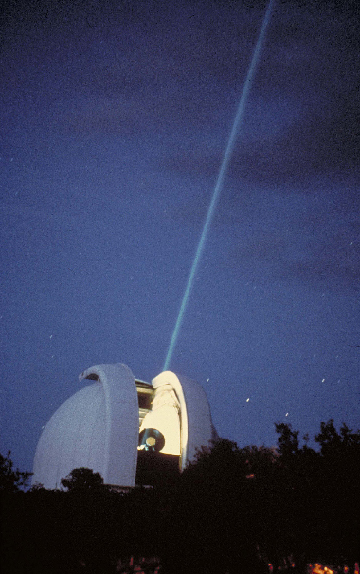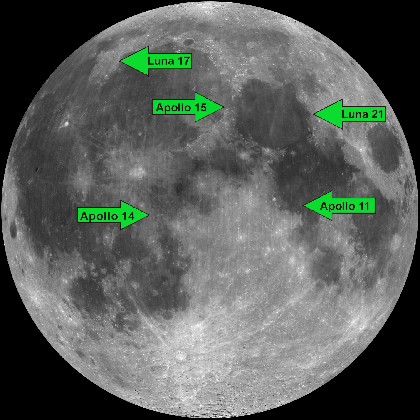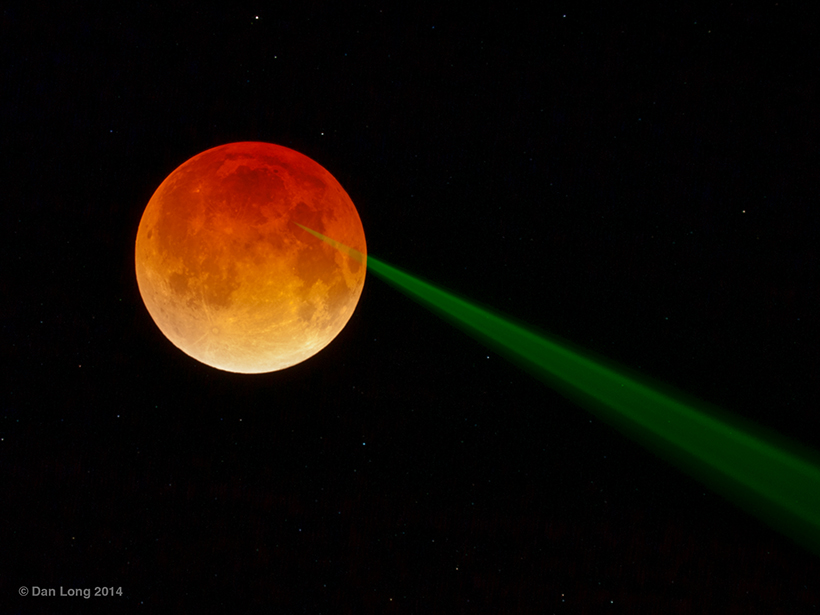When Neil Armstrong and Edwin “Buzz” Aldrin blasted off the Moon on 21 July 1969, they left a couple of packages at Tranquility Base. One was a solar-powered seismometer that collected 21 days of observations before expiring in late August. The other was an aluminum frame filled with chunks of fused-silica glass that looked a bit like a high-tech egg crate.
Along with similar devices left on the Moon by Apollo 14 and 15, the instrument is still working—the only Apollo surface experiment that continues to provide data.
Known as a lunar laser ranging retroreflector, it bounces pulses of laser light back to their sources on Earth. Scientists time the round-trip travel time of each pulse, allowing them to measure the Earth-Moon distance to within a millimeter. A half century of these observations has provided precise measurements of the shape of the Moon’s orbit, wobbles in the Moon’s rotation, and other parameters. Those, in turn, have helped scientists determine the Moon’s recession rate, probe its interior structure, and test gravitational theory to some of the highest levels of precision yet obtained.

“This is a venerable technique that’s provided some of our best science about how gravity works,” says Tom Murphy, a professor of physics at the University of California, San Diego, who has headed a lunar laser-ranging project since the early 2000s.
Peculiar Prisms on the Moon
The devices left on the Moon by Apollo astronauts (as well as two others aboard Soviet Lunokhod rovers) consist of arrays of corner cube reflectors.
“These are like peculiar prisms—they’re shaped like the upper corner of a room,” says Doug Currie, a professor of physics at the University of Maryland in College Park who has worked in the field since the 1960s. “You could throw a tennis ball in the corner, and it would hit all three sides and bounce back to you. The lunar reflectors do the same thing. The difference is, you can send up to 1023 photons at a time, and you’re happy when one comes back.”

The Apollo 11 and 14 retroreflectors each contain one hundred 3.8-centimeter corner cubes, whereas the Apollo 15 array contains 300, so it produces the strongest return signal.
Photons are beamed toward the Moon through a telescope, such as the 3.5-meter telescope at Apache Point Observatory in New Mexico, the largest instrument ever to conduct lunar laser ranging. The laser is fired in 100-picosecond pulses—“bullets of light” just 2 centimeters thick, says Murphy, who heads the Apache Point Observatory Lunar Laser-ranging Operation (APOLLO).
No more than a few photons from each pulse return to the telescope, but the telescope fires thousands of laser bullets during each ranging session, allowing it to collect thousands of photons per session. Statistical analysis smooths out the differences in ranges between individual photons, producing a distance to the Moon with an accuracy of about 1 millimeter.
APOLLO ranges to the Moon about six times per month and targets all five of the retroreflectors during each session. France’s Observatoire de la Côte d’Azur, the other major lunar-ranging station, uses a smaller telescope but has begun ranging with an infrared laser, which is about 8 times more efficient than the standard green laser.
An Array of Scientific Contributions
Lunar laser ranging’s first scientific contribution was to produce an accurate measurement of how quickly the Moon is moving away from Earth: 3.8 centimeters per year. The retreat is the result of the ocean tides on Earth, which cause our planet’s rotation period to slowly increase. To balance the books on the overall motion of the Earth-Moon system, the Moon speeds up, causing it to move away from Earth.

Collecting data from the network of five retroreflectors over the course of several decades also has allowed planetary scientists to probe the Moon’s interior by measuring how the Moon “wobbles” on its axis.
Some of those wobbles are caused by the Moon’s elliptical orbit, but others are produced by motions within the Moon itself. Measurements of that interior “sloshing” revealed that the Moon has a liquid outer core that’s about 700 kilometers in diameter, roughly 20% of the Moon’s overall diameter.
“Everybody came in thinking, ‘we really know the Moon,’ but we didn’t,” says Peter Shelus, a research scientist at the University of Texas at Austin, which conducted lunar laser-ranging operations for more than 40 years. “We didn’t know the lunar rotation as well as we thought. As we got more data, though, everything fell into place, and the rotation rate allowed us to probe the interior.”
When the lunar laser-ranging experiment was conceived in the early 1960s, however, learning about the Moon itself was a secondary goal. The primary goal was to study gravity. And so far, laser ranging has confirmed Isaac Newton’s gravitational constant to the highest precision yet seen and confirmed other tenets of gravitational theory, including the equivalence principle, which says that gravitational energy should behave like other forms of energy and mass.
“What we’re after, the flagship science, is the strong equivalence principle,” says Murphy. “By, quote, dropping Earth and the Moon toward the Sun, we can use the Earth-Moon separation as a way to explore whether two bodies are pulled toward the Sun differently. That’s a foundational tenet of general relativity, and it would be very important if we saw a violation there.”
So far, the lunar laser-ranging experiment has confirmed relativity’s predictions about the equivalence principle to the highest precision yet seen—within the experiment’s margin of error, Earth and the Moon “fall” toward the Sun at the same rate.
“There’s Still Work to Do”
Despite the experiment’s success, Murphy says he’s “disappointed” in the results to date.
“We’ve managed to produce measurements we’re all confident in at the millimeter level of accuracy, but the model that it takes to extract science from this result has been slow to catch up. So we haven’t yet seen the order-of-magnitude level of improvement that we hoped for in those tests. We’ve seen maybe a factor-of-2 level of improvement, but that’s not very satisfying.”
“There’s stuff in the model and in the data that we still don’t understand. There’s still work to do.”
James Williams, a senior research scientist at NASA’s Jet Propulsion Laboratory and another pioneer in the lunar-ranging field, agrees that there’s work to do to improve our understanding of the results.
“We’ve measured the Earth-Moon acceleration toward the Sun to 1.5 parts in 1013, which is a very, very sensitive test. It limits certain gravitational theories,” Williams says. “But there’s stuff in the model and in the data that we still don’t understand. There’s still work to do.”
While the models catch up, the observational side of the project could stand some improvement as well, scientists say.
The Lunokhod reflectors, for example, can be used only around sunrise and sunset; thermal problems scuttle observations at other points in the lunar cycle. The Apollo reflectors are degrading, probably because micrometeorite impacts on the surface are splashing dust onto the corner cubes. All of the current retroreflectors are placed near or north of the equator, leaving the southern half of the lunar globe uncovered. And current ranging is so precise that the orientation of the retroreflectors can cause a problem: As the laser bounces off opposite corners of an array, it can increase uncertainty in the measurements by a few centimeters.
Currie has proposed sending new reflectors to the Moon using a new corner cube design.
“We’ve been working on a 100-millimeter glass reflector that’s basically a scaled-up version of the Apollo reflectors,” he says. “You don’t have to worry whether a returned photon came from the near corner or the far corner of an array. We think that’ll improve the accuracy of a shot by a factor of a hundred. We’ve had to solve some thermal issues with the reflectors and the frame, but we can put together a package that can fly.”
Currie’s group has submitted proposals to NASA to strap one of the new modules on an upcoming lunar mission and has signed an agreement with Moon Express, a company vying to launch a lander.
“If you’re going to the Moon, these are almost no-brainer accompaniments,” says Murphy. “Their success is almost guaranteed; they require no power, they’ll work for decades and decades….It’s a low-cost, high-reward investment, which is why it was included on the initial Apollo mission.”
It’s an investment that’s still paying dividends 50 years later.
—Damond Benningfield ([email protected]), Science Writer
17 June 2019: This article has been updated to correct how lunar retreat is influencing Earth’s rotation rate.
Citation:
Benningfield, D. (2019), Seeing the light, Eos, 100, https://doi.org/10.1029/2019EO122981. Published on 11 June 2019.
Text © 2019. The authors. CC BY-NC-ND 3.0
Except where otherwise noted, images are subject to copyright. Any reuse without express permission from the copyright owner is prohibited.

